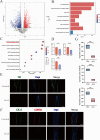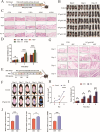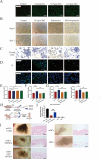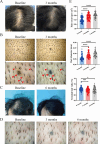Therapeutic potential of isoproterenol in androgenetic alopecia: activation of hair follicle stem cells via the PI3K/AKT/β-Catenin signaling pathway
- PMID: 40518527
- PMCID: PMC12168277
- DOI: 10.1186/s13287-025-04418-y
Therapeutic potential of isoproterenol in androgenetic alopecia: activation of hair follicle stem cells via the PI3K/AKT/β-Catenin signaling pathway
Abstract
Background: Androgenetic alopecia (AGA) is characterized by the depletion or dormancy of hair follicle stem cells (HFSCs), leading to hair thinning and miniaturization. Reactivating the dormant HFSCs is a promising therapeutic approach. Adrenergic β2 receptor (ADRB2) activation has been shown to promote hair growth in animal models via the Sonic Hedgehog (SHH) pathway, but its potential for treating clinical AGA patients remains unexamined.
Methods: We investigated the role of the PI3K/AKT signaling pathway in AGA pathogenesis, focusing on the hair follicle-sympathetic nerve axis. The ADRB2 agonist, isoproterenol (ISO), was administered to assess its effects on AGA hair follicle organ culture model and HFSC proliferation. The mechanisms underlying these effects were explored by analyzing the PI3K/AKT/β-Catenin pathway.
Results: Our results showed abnormal PI3K/AKT pathway expression in AGA hair follicles, with associated defects in the hair follicle-sympathetic nerve axis. ISO treatment accelerated AGA hair follicle growth and promoted the proliferation of HFSC. Mechanistically, ISO facilitated the HFSC activation by modulating the PI3K/AKT/β-Catenin pathway.
Conclusions: ISO effectively promotes hair growth in both animal models and AGA patients. ISO stimulating the proliferation of dormant cell population enriched in HFSC. This process was likely mediated by the PI3K/AKT/β-Catenin pathway. These findings provide novel insights into the reactivation of HFSCs and suggest that adrenergic signaling stimulation may be a promising strategy for managing hair loss.
Keywords: Androgenetic alopecia; Clinical trial; Hair follicle stem cell; Hair regrowth; Isoproterenol; PI3K/AKT/β-catenin signaling.
© 2025. The Author(s).
Conflict of interest statement
Declarations. Ethics approval and consent to participate: (1) Title of the approved project: A study of the therapeutic effect of isoproterenol on androgenetic alopecia; Name of the institutional approval committee: Medical Ethical Committee of Southern Medical University; (3) Approval number: NFEC-2021-349; (4) Date of approval: 2022-11-03. The patients provided their written informed consent for participation in the study and the use of samples. Animal study: (1) Title of the approved project: Isoproterenol intervention in C57/BL6 mice in vitro; Name of the institutional approval committee: Animal Care and Use Committee, Southern Medical University; (3) Approval number: IACUC-LAC-20210318002; (4) Date of approval: 2021-09-15. Consent for publication: The patients / participants provided their written informed consent to participate in this study Competing interests: The authors have no financial interest to declare in relation to the content of this article.
Figures







Similar articles
-
Retinoic acid drives hair follicle stem cell activation via Wnt/β-catenin signalling in androgenetic alopecia.J Eur Acad Dermatol Venereol. 2025 Jan;39(1):189-201. doi: 10.1111/jdv.20000. Epub 2024 Apr 17. J Eur Acad Dermatol Venereol. 2025. PMID: 38629345 Free PMC article.
-
Dahuang-Gancao decoction ameliorates testosterone-induced androgenetic alopecia in mice.J Ethnopharmacol. 2025 Feb 11;341:119347. doi: 10.1016/j.jep.2025.119347. Epub 2025 Jan 10. J Ethnopharmacol. 2025. PMID: 39800247
-
Restoration of follicular β-catenin signaling by mesenchymal stem cells promotes hair growth in mice with androgenetic alopecia.Stem Cell Res Ther. 2024 Nov 19;15(1):439. doi: 10.1186/s13287-024-04051-1. Stem Cell Res Ther. 2024. PMID: 39563459 Free PMC article.
-
Pathophysiological mechanisms of hair follicle regeneration and potential therapeutic strategies.Stem Cell Res Ther. 2025 Jun 15;16(1):302. doi: 10.1186/s13287-025-04420-4. Stem Cell Res Ther. 2025. PMID: 40518544 Free PMC article. Review.
-
Innovative strategies for the discovery of new drugs against androgenetic alopecia.Expert Opin Drug Discov. 2025 Apr;20(4):517-536. doi: 10.1080/17460441.2025.2473905. Epub 2025 Mar 11. Expert Opin Drug Discov. 2025. PMID: 40029254 Review.
References
-
- Griggs J, Burroway B, Tosti A. Pediatric androgenetic alopecia: A review. J Am Acad Dermatol. 2021;85(5):1267–73. - PubMed
-
- Ellis JA, Sinclair R, Harrap SB. Androgenetic alopecia: pathogenesis and potential for therapy. Expert Rev Mol Med. 2002;4(22):1–11. - PubMed
-
- Manabe M, Tsuboi R, Itami S, Osada SI, Amoh Y, Ito T, Inui S, Ueki R, Ohyama M, Kurata S, Kono T, Saito N, Sato A, Shimomura Y, Nakamura M, Narusawa H, Yamazaki M. Guidelines for the diagnosis and treatment of male-pattern and female-pattern hair loss, 2017 version. J Dermatol. 2018;45(9):1031–43. - PubMed
-
- Vasserot AP, Geyfman M, Poloso NJ. Androgenetic alopecia: combing the hair follicle signaling pathways for new therapeutic targets and more effective treatment options. Expert Opin Ther Targets. 2019;23(9):755–71. - PubMed
MeSH terms
Substances
Grants and funding
LinkOut - more resources
Full Text Sources
Medical
Miscellaneous

